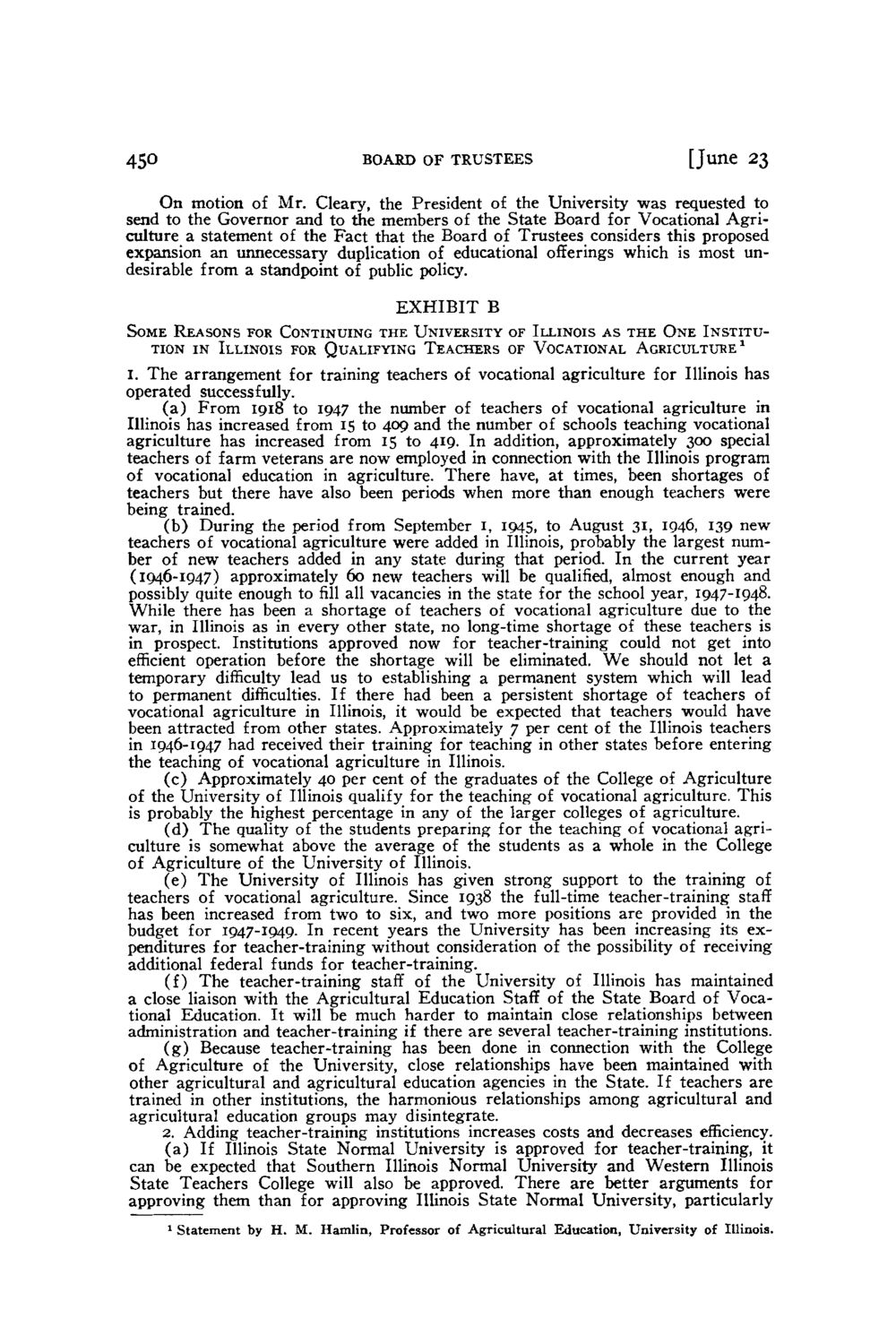| |
| |
Caption: Board of Trustees Minutes - 1948
This is a reduced-resolution page image for fast online browsing.

EXTRACTED TEXT FROM PAGE:
450 BOARD OF TRUSTEES [June 23 On motion of Mr. Geary, the President of the University was requested to send to the Governor and to the members of the State Board for Vocational Agriculture a statement of the Fact that the Board of Trustees considers this proposed expansion an unnecessary duplication of educational offerings which is most undesirable from a standpoint of public policy. EXHIBIT B SOME REASONS FOR CONTINUING THE UNIVERSITY OF ILLINOIS AS THE O N E INSTITUTION IN ILLINOIS FOR QUALIFYING TEACHERS OF VOCATIONAL AGRICULTURE 1 1. The arrangement for training teachers of vocational agriculture for Illinois has operated successfully. ( a ) From 1918 to 1947 the number of teachers of vocational agriculture in Illinois has increased from 15 to 409 and the number of schools teaching vocational agriculture has increased from 15 to 419. In addition, approximately 300 special teachers of farm veterans are now employed in connection with the Illinois program of vocational education in agriculture. There have, at times, been shortages of teachers but there have also been periods when more than enough teachers were being trained. (b) During the period from September 1, 1045, to August 31, 1946, 139 new teachers of vocational agriculture were added in Illinois, probably the largest number of new teachers added in any state during that period. In the current year (1946-1947) approximately 60 new teachers will be qualified, almost enough and possibly quite enough to fill all vacancies in the state for the school year, 1947-1948. While there has been a shortage of teachers of vocational agriculture due to the war, in Illinois as in every other state, no long-time shortage of these teachers is in prospect. Institutions approved now for teacher-training could not get into efficient operation before the shortage will be eliminated. We should not let a temporary difficulty lead us to establishing a permanent system which will lead to permanent difficulties. If there had been a persistent shortage of teachers of vocational agriculture in Illinois, it would be expected that teachers would have been attracted from other states. Approximately 7 per cent of the Illinois teachers in 1946-1947 had received their training for teaching in other states before entering the teaching of vocational agriculture in Illinois. (c) Approximately 40 per cent of the graduates of the College of Agriculture of the University of Illinois qualify for the teaching of vocational agriculture. This is probably the highest percentage in any of the larger colleges of agriculture. (d) The quality of the students preparing for the teaching of vocational agriculture is somewhat above the average of the students as a whole in the College of Agriculture of the University of Illinois. (e) The University of Illinois has given strong support to the training of teachers of vocational agriculture. Since 1938 the full-time teacher-training staff has been increased from two to six, and two more positions are provided in the budget for 1947-1949. In recent years the University has been increasing its e x penditures for teacher-training without consideration of the possibility of receiving additional federal funds for teacher-training. (f) The teacher-training staff of the University of Illinois has maintained a close liaison with the Agricultural Education Staff of the State Board of Vocational Education. It will be much harder to maintain close relationships between administration and teacher-training if there are several teacher-training institutions. ( g ) Because teacher-training has been done in connection with the College of Agriculture of the University, close relationships have been maintained with Other agricultural and agricultural education agencies in the State. If teachers are trained in other institutions, the harmonious relationships among agricultural and agricultural education groups may disintegrate. 2. Adding teacher-training institutions increases costs and decreases efficiency. ( a ) If Illinois State Normal University is approved for teacher-training, it can be expected that Southern Illinois Normal University and Western Illinois State Teachers College will also be approved. There are better arguments for approving them than for approving Illinois State Normal University, particularly 1 Statement by H. M. Hamlin, Professor of Agricultural Education, University of Illinois.
| |